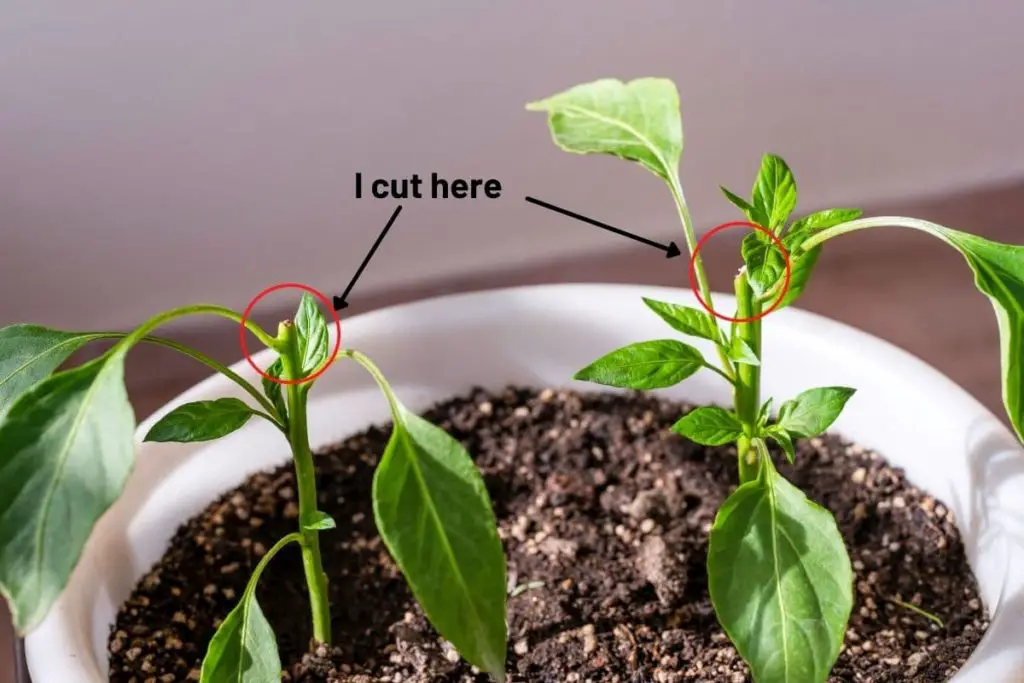While the gardening world may debate upon the multiple ways to prune pepper plants–one thing is in consensus: pruning pepper plants result in higher yield!
In this article, I am going to take you on a pepper plant pruning journey; detail the whys, the whens, and the hows. Let’s begin!
Why should I Prune Pepper Plants?
Pruning is the process of removing specific branches and layers to improve the growth and development of particular parts of the plant. Pepper plants are pruned to become more fuller plants and result in higher yield.
Once you prune the branches and leaves which are not as beneficial, it allows the plant to exhaust its energies and growth elsewhere. This leads to healthier and richer fruit growth.
One question that is often asked is: “is it necessary to prune my pepper plant?” The answer is: depends upon the results. If your pruning is beneficial, or without it, there is no significant yield, then by all means, do it. If it’s not resulting in any significant changes, you can do away with it.
However, you have to remain careful not to prune excessively. Otherwise, the plant will become thin and weary, which negatively impacts the fruit growth.
Finally, one also needs to be cognizant of the season/time in which they prune, as the yield also depends upon when the pruning has taken place. So below is a detailed guide on when you should prune specific pepper plants.
When to Prune Pepper Plants?
The techniques involved in pruning pepper plants largely depend upon the season when it’s done. In this case, there are three main seasons for pepper plant pruning:
- Early season
- Mid-season
- Late season
Early season pruning:
Early season pruning is basically to give the pepper plant a desired shape to grow in. This helps improve the branching of plant, root production, and air circulation throughout the plant.
Mid-season pruning:
Mid-season pruning is largely done to keep the pepper plant pest and insect-free, and keep away from other related diseases. Mid-season pruning is also beneficial to reduce heavy foliage so the plant can focus on healthy fruit growth.
Late season pruning:
Late season pruning is usually done to enhance and enrich the color of the pepper fruit or to accelerate its ripe time before the season ends.
How to prune
Now that we have covered the three main seasons for pepper pruning, it’s time to get into detail about the particular techniques for each season.
Early season pruning:
There are multiple pepper pruning techniques for early season pruning detailed below:
- With small-fruited plants, like habanero and jalapeno peppers, the central growing point of the plant may be pruned or pinched early in the growth. You can do this by removing half to one inch of the plant to improve branching so that the plant develops more fully and wholly and gives healthier and higher yield.
However, the large-fruited plants, like bell peppers, may not be pruned the same way because they develop fully into Y-shaped plants (this main Y-shape should never be tampered with). In fact, pruning them early in the season could negatively impact their flower and fruit growth.
- To encourage the circulation of air throughout the plant, expand the plant by pruning it to a few main stems early in the growth. This allows sunlight to easily reach the interior of the plant for a good development. Moreover, expanding the system would also make it easier for each branch to absorb sunlight and water, allowing the foliage enough space to dry out.

Mid-season pruning:
Some of the ways you can prune your pepper plant mid-season are:
- Insects and small animals such as snails and slugs are very attracted towards pepper plants. Most of them get access to plants through leaves close to the soil or ground. Thus, to protect against these pests and predators, prune the leaves of the plant from close to the ground. As a best practice, pruning the leaves five to eight inches from the bottom is a good idea. Leave the steam leafless from the bottom.
- The most typical form of pruning mid-season is to get rid of any spotted, yellowed, or damaged leaves from the plant. You can prune specific and damaged leaves on a weekly or fortnightly basis to ensure that your fruits are healthy and the plant remains growing. This would also help save the pepper plant from any fungal diseases it is prone to.
- The third way to prune your pepper plant mid-season, mainly the large-fruit varieties, is to cut off suckers or any nodes that tamper with the natural Y-shape of the pepper plant. Leaving the suckers to grow in large-fruit plant varieties focus the growth on leaves and steams, instead of flowers and fruits.
However, suckers are good for small-fruit pepper plant varieties as it makes the plant more whole and bushier, which also induces greater growth of the flowers.
Late season pruning:
Late season pruning benefits pepper in healthier colors and richer taste. Ways to prune pepper plant in this season are as follows:
- Pruning off overarching leaves or branches on top of developing fruits can help the fruit reach their “true” color quickly. The color also helps enrich the taste of the fruit. Although, some fruits, even if their flowers are immature, are considered ripe. Bell peppers, red, yellow, green, or even purple benefit from pruning in late-season.
- If you expect a frost to arrive before your fruit has ripened, fasten the process by pruning the branches and side shoots. You can prune the topmost three to six inches. Furthermore, to encourage faster ripening, make your most educated decision, and prune off any flowers or fruits that will still take time to mature. This way, the plant is allowed to expend its energies only on the fruits that can mature before the frost and accelerate the process.
While pruning, regardless of any specific season, always ensure that your pruners are disinfected and clean. Also, you should also wear gloves. As a good practice, try pruning on a day in which there is no forecast of rain and the foliage is dry. This is because pepper plants are prone to fungal diseases due to moisture in pruned openings. Lastly, always discard your pruned stuff safely and far away from the compost or the plant.
Some other methods to attain higher yield:
- Pinching pepper plants:
Pinching fruits help the plant focus more on fruit production instead of the roots and branches. This should especially be done prior to transplantation or when the first few buds have sprung forth. This strategy is used for other fruits as well, such as tomatoes.
- Space out your peppers:
Peppers thrive in conditions that let them breathe more and develop more fully. You can do this by the pruning technique of early-season, which cuts branches so they space out more and grow widely.
In this way, sunlight abundantly reaches all parts of the plant, and no part feels abandoned. Pepper plant growers recommend growing them 18-24” apart for maximum growth.
Finally, just ensure that your pepper plant is receiving enough sunlight, as it directly dictates the number of peppers your plant can grow!
It is true that pepper pruning requires a lot of patience and discipline, but it is true for tending to any living being–whether an animal or a plant. And the process itself, as well as the output, is really rewarding, according to all gardeners.
If you’re a visual person, check out this guide from Pepper Geek on YouTube.
Do all pepper plants benefit from pruning?
Pruning for peppers is not necessary, but recommended to attain higher yield. People who enjoy gardening and growing fruits and vegetables are usually looking for ways to increase their current yield to an ideal amount. The multiple ways of pruning talked about in this article are a way towards that experiment.
In any case, if you are looking for some definite answers, hear me out: pruning creates stems stronger and sturdier which are less likely to break. Further, it can give your plant the desired shape and shine.
Pruning can be done on any type of pepper plant, no matter if they bear small fruits or large. However, keep in mind that the techniques involved in pruning for these two varieties differ. So this was all about pepper pruning. Hope you make use of the multiple techniques and have more peppers to eat each season. Happy pruning!
